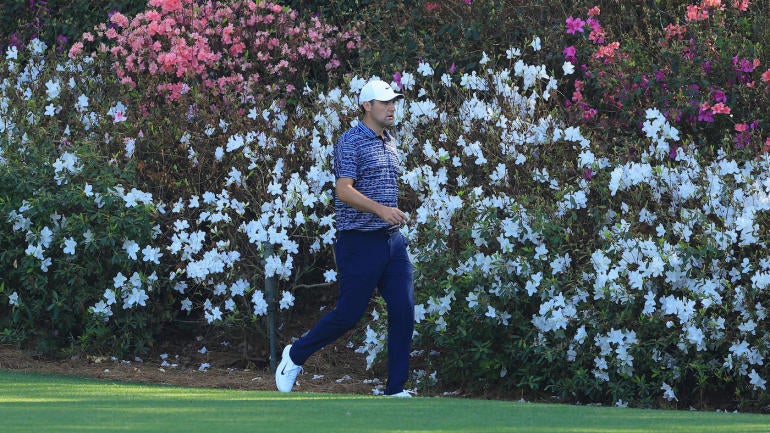
The 2023 Masters convene at Augusta National Golf Club just like the 86 others that preceded it ... except this one will be a bit different. One of the most famous golf holes in the world -- the par-5 13th, "Azalea" -- has received a massive makeover. Azalea has been lengthened from 510 yards to 545 yards for the 87th Masters and beyond.
Some golfers set to tee it up two weeks from now have gotten a taste of how the 13th is going to play during the tournament. Rory McIlroy and last year's champion, Scottie Scheffler, both visited Augusta in recent weeks and definitely noticed changes in how the hole plays.
"It's longer," said Scheffler on Tuesday at the WGC-Dell Match Play in Austin, Texas. "It's a lot longer."
Will it be harder, too? The par 5 has played to an historical scoring average of 4.77, making it the easiest hole at Augusta National. That's certainly not how it was originally designed to play with the risk-reward of a second shot that might not clear Rae's Creek quite high. However, modern equipment led to Azalea becoming a driver-wedge hole for some of the longest players in the world.
Depending on wind direction, that's not going to be the case anymore.
Apropos of absolutely nothing:
— No Laying Up (@NoLayingUp) March 15, 2023
Asked Rory about the new back tee on 13.
Conditions: cold, soft, and into the wind.
“Driver, 5-iron the last couple of days.” pic.twitter.com/n8IVO509Oo
"[It's] definitely harder," said Scheffler, who beat McIlroy by three strokes at Augusta last year. "I think with modern technology and that tee shot ... I used to hit 3-wood there because I can sling hook a 3-wood. I can't sling hook a driver on purpose. The ball just doesn't spin enough. I can do it on accident, but I can't quite sling it on purpose because I like to fade my driver more off the tee. And so, when it comes to that tee shot and hitting a hard hook with the driver, it's not really a shot that I'll try just because it's not worth the risk for me."
It appears that extra 35 yards could change the tenor of the entire tournament this year and perhaps beyond. (Just imagine how things would look if the proposed USGA and R&A rollback rule goes through and Augusta National adopts it for the Masters.)
"That hole was one where I'd hit the same shot I hit on 10," added Scheffler. "The 3-wood, it has enough spin where the ball can actually stay in the air. With the driver, when I hook it, the ball doesn't have enough spin to where it can stay in the air and hook that much. It kind of nosedives. But the 3-wood, I can sit up there and it will just be like a boomerang.
"But that's really the biggest change for me. Now, I'll just hit driver kind of out towards the corner and try and use more of the contouring to get the ball that way versus before. I should say it this way: My driver is now going where my 3-wood kind of used to go. My 3-wood, I could maybe get it a little bit further around the corner, but my driver is now going to where that 3-wood was before."
Scheffler isn't the only top-two player in the world considering the 3-wood. Jon Rahm, who previously has referenced his desire to leave his 3-wood short of the trees running up the right side, said the change is going to benefit longer players (such as himself) and that he might still go 3-wood off the tee.
"From what I've talked to people, you can't go through hitting driver unless you're downwind," said Rahm. "I think my line won't really change. The club selection might change. What you won't see is people possibly being able to turn the corner and having 8- or 9-iron in or maybe even 7-iron. Now, it will play a little bit more out to the right to hopefully give yourself a better line.
"But I can anticipate a lot of people hitting a good tee shot and still having to curve it around the trees a little bit. And obviously, we're going to see a lot of lay-ups. I think it plays in my favor. It's going to play obviously in the longer hitters' favor as well just because I may be comfortable enough from 220 to go at the green, but somebody that might have a 2-iron plus or a long iron with that lie might not feel as comfortable."
Unspoken here: Though a good tee shot might be out to the right, a great one might take on the creek up the left. It's clear that some of the original design has been restored in the golf hole.
Here's Garrett Morrison of The Fried Egg on the 13th from a few years ago.
This is a risky play, and individual players may decide that the juice isn't worth the squeeze. But the rewards are clear. "The player is first tempted to dare the creek on his tee shot by playing in close to the corner," Bobby Jones wrote in his 1960 book Golf Is My Game, "because if he attains his position he has not only shortened the hole, but obtained a more level lie for his second shot. Driving out to the right not only increases the length of the second, but encounters an annoying side-hill lie."
The 13th will seemingly once again reward taking on the creek and the flatter path. And regardless of whether it does or not, it has become clear based on the comments from top players that changes to this hole -- such a pivotal one over the history of the tournament -- will almost certainly affect how the 2023 Masters plays out.





















